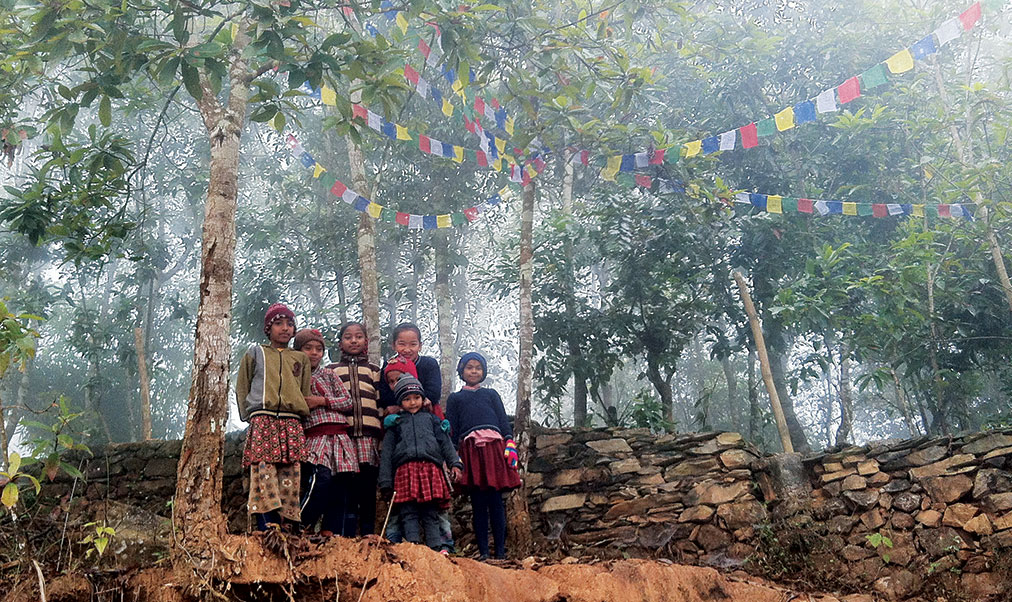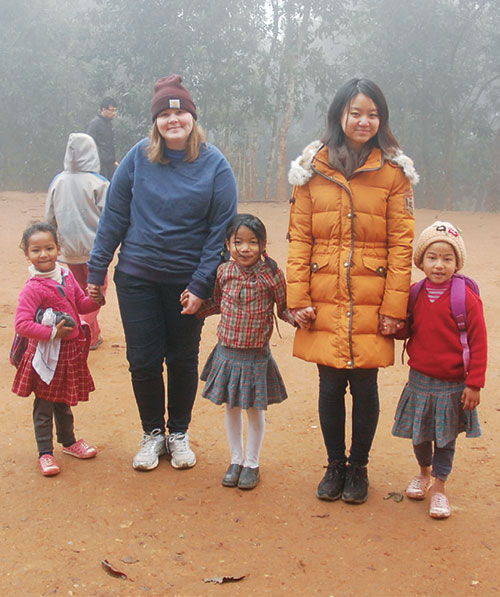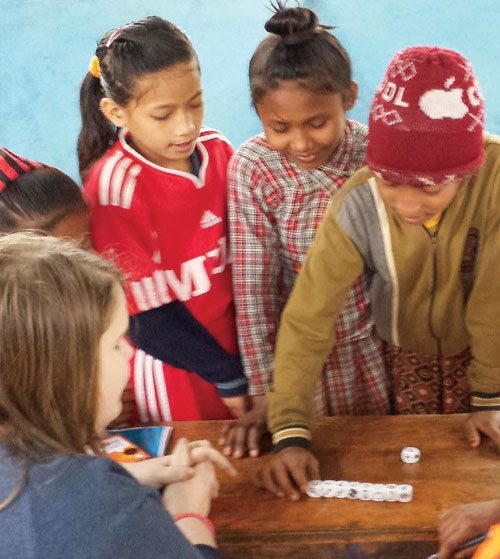
As a dense fog receded into the Nepali jungle, 60 students, teachers and volunteers from Maya Universe Academy gathered before the school day to participate in a game of dodgeball—students versus adults. The playtime followed the delivery of morning announcements and recitation of original student poems. When I and three other members of the Wesson Honors Program volunteered at Maya, we were welcomed into the community, which means the kids did not hold back—they pummeled us in every round.
We were there to help provide Nepali children with greater access to educational resources and to strengthen a burgeoning relationship with Maya as the second Colby-Sawyer group to visit. Last year, after much planning and guidance from Professor of Humanities Ann Page Stecker, Nishchal Banskota ’15 and three other Wesson Honors students received funding to travel to Nishchal’s home country and build a bamboo classroom for Maya.
This January, Deepesh Duwadi ’17 of Nepal; Ge Huang ’15 of Nanchong, China; Banskota and I helped continue the work at Maya. Joined by Professor of Fine and Performing Arts Jon Keenan, our mission this time was to transform an empty building into a library and establish a water filtration system.
Maya is in the rural district of Tanahun, more than 125 miles west of Kathmandu. To reach the academy, we boarded a bus that barreled along a serpentine highway that jutted out of the Annapurna mountain range. After five hours, we reached the last city on the map and traded our bus for the Jeep that makes the hour-long ascent to Maya once a day.
The remote nature of villages like the one Maya serves means that its young people have little access to quality educational resources, and the academy’s founders developed a radical model to meet the community’s needs. Maya means love in Nepali and it is this, rather than money, that the academy uses as a medium of exchange. Instead of paying tuition, parents volunteer at the school two days a month. With the additional help of volunteers, such as Colby-Sawyer students, Maya offers some of the world’s most brilliant children the education that they deserve.

A Flexible Future
Time moves differently in Nepal. Our journey there propelled us forward through nearly 10 time zones, but I also sensed a more subtle shift. As we walked through Patan Durbar Square’s red-tiled courtyards just three months before they were ravaged in the April earthquakes, I marveled at the towering pagodas, reminders of a distant century that now serve as romantic backdrops while young couples snap selfies. Nishchal and Deepesh reminded me that time is flexible in Nepal. It explains the confluence of past and future at Maya.
During our tour of Maya’s facilities, a long-term volunteer led us to a large patch that served as the organic vegetable farm. Off to the side, children played on a swing while chickens and goats grazed nearby. The parents maintain the farm and sell the produce to generate revenue for the school, and it jumpstarts lessons on agriculture and economics. At Maya, children are taught to value local skills and traditions.
At the same time, living at Maya was like glimpsing the future, and in fact, according to the country’s traditional calendar, it was the year 2071. As we sat down to a special dinner that included chicken, a rarity at Maya, multiple languages filled the air. In addition to learning Nepali and English, the children pick up French, Korean and Chinese from the volunteers.
Guests share other knowledge as well. Professor Keenan delivered 10 ceramic water filters to the school and taught the students how to use them so that they no longer have to hike the mile to a freshwater spring in the jungle twice a day.
After dinner, when all the boarding students had gone to bed, Maya co-founder Yoon welcomed us with a brief speech. “This,” he declared, gesturing widely to indicate the school, “is what I believe in.” He explained that the education the students receive at Maya will ensure they grow up to be creative and compassionate enough to alleviate structural barriers in Nepal.
It’s a tall order—Nepal has a host of challenges. By coincidence, all four of us had taken Associate Professor of Social Sciences and Education Eric Boyer’s course on revolutions in the semester leading up to the trip. Nischal and Deepesh had taught the class about the many problems facing their country. Since the monarchy dissolved, Nepal has run on an interim constitution, unable to draft a rule of law that appeases all political parties.
If anyone can find solutions to the political unrest, though, it’s the children we met at Maya. Ge and I taught four English classes, and before the lessons we asked each group of fifth graders their names. Without prompting, they included their dream jobs, as if their goals are intrinsically tied to their identities: “My name is Manish, and I want to become an engineer.” “My name is Bishnu, and I want to become a doctor.”
While we taught English, Professor Keenan held an art class and tasked his students with creating an ideal global village out of clay. They molded temples, schools, rivers, roads, farms, cell phones and soccer balls. “When students encountered a technical issue, such as building a bridge or temple,” Professor Keenan said, “they learned how to problem solve, cooperate and rebuild.” The lesson allowed them to envision an ideal Nepal and how to make it a reality.

Give and Take
The education model at Maya is reciprocal. Visiting a foreign country where I was ignorant of the language and way of life encouraged me to adopt a new perspective. Before our trip, I had to navigate the bureaucracies of the U.S. Department of State and New Hampshire DMV in order to renew my passport with an expired driver’s license. I saw this obstacle as a “Turn Back Now” sign and was sure my paperwork would be denied. But in Nepal, uncertainty is embraced. Challenges, even those that originate from the state, are opportunities for people to come together and solve problems.
For example, local strikes over the constitution shut down traffic on our first of six days at Maya, so Nischal walked back toward the city for several hours until he found an open shop to secure supplies. The rest of us spent the day painting the boys’ boarding room and completing miscellaneous chores. By the time vehicles were allowed to run again, it was night. We unloaded the paint and boards in the dark and set to work after breakfast the next day.
By the end of our visit, we filled the library we helped create with nearly 100 picture books we had brought with us, thanks to donations from local organizations and community members including Sally Williams Cook ’74. The global village the children created in Professor Keenan’s class is on permanent display in the center of the room.
During the strikes, Ge and I taught our English classes about Freytag’s pyramid, a concept in literary theory that presupposes all stories have the same basic structure. Of course, authors have challenged this idea, just as people have challenged our concept of time, and of borders. After visiting Nepal, all these constructs seem more malleable.
We planned an activity at the end of each lesson to inspire the students to create their own stories. In one class, a young girl raised her hand.” Miss, I’ve already written a story,” she said, and she recited a whimsical tale about a man falling asleep under a chilaune tree. I like to think that all people, including her, are in charge of their own stories and capable of rewriting their futures.
-Jaclyn Goddette ’16 is an English major from Newport, N.H., and a student writer with College Communications. She vows to return to Nepal as soon as possible.


